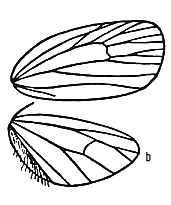|
Eugoa
Walker
Type species: aequalis Walker,
Borneo.
Synonym: Hectogama Meyrick
(type species dissozona Meyrick, New Guinea).
This is one of the larger
Indo-Australian genera. It is probably best defined on a combination of forewing
venation and facies characters. All forewing veins are present, with three
bifurcate systems: (R3, R4); (R5, M1); (M2, M3). This feature (Fig 7b) is also
seen in Euconosia and the next two genera. R1 anastomoses with Sc. The
forewing facies usually consists of one or two dark discal dots (if two, then
quite close together and set slightly obliquely, not longitudinal and well
separated as in Holocraspedon and allies) that are flanked by diffuse,
often broad, oblique fasciae, usually a postmedial and frequently also an
antemedial. The submarginal, when present, has a characteristic irregularity,
with a short centre section displaced distad. The ground colour is usually some
shade of fawn or grey, sometimes very pale, and the markings and suffusions are
respectively brown or blackish. The hindwings are often more of a creamy colour.
The antennae of the male are ciliate or serrate, sometimes bipectinate.

Fig 7b: Eugoa humerana Walker
The male genitalia are
extremely variable in form, usually with the distal part of the valve entire,
sometimes with a saccular process and frequently with a zone of costally
directed setae along most of its length. In a few species the tegumen is
shouldered or bears processes. The aedeagus vesica is often convolute but not
elongate except for a frequently occurring tapering diverticulum, and may have
cornuti. The ductus ejaculatorius may also be sclerotised.
The female usually has the
ductus and corpus bursae short, the former often broad, the latter generally
spined or scobinate. There may be a longer appendix bursae, and sometimes there
are spines or other structures from the lamellae vaginales.
The greatest diversity is in
the Oriental tropics, particularly in Sundaland, but there are one or two
species groups in New Guinea, and weak representation in Australia, Japan and
Africa. Some attempt has been made to identify groupings in the Bornean fauna.
These will be identified in the taxonomic note for the first in a sequence. The
biology of one species is discussed below.
The biology of the Japanese E.
grisea Butler was described by Issiki et al (1965), with an
illustration of the larva. The larva is pale grey with more rufous verrucae and
mottling, the verrucae bearing whitish setae. There are dorsolateral black
marks, roughly triangular and irregularly surrounded by cream, two on each side
of each segment, adjacent to each other across the intersegmental membrane. The
host was foliose liverwort growing on tree trunks.
<<Back
>>Forward <<Return
to Contents page
|

